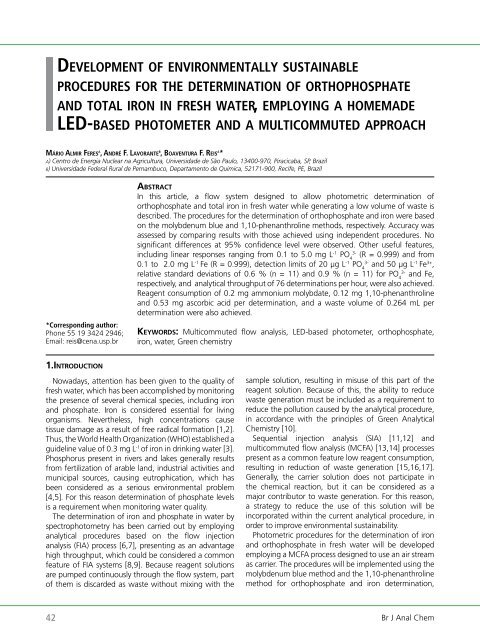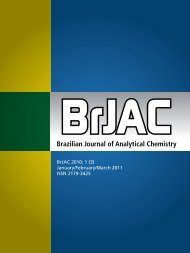Brazilian Journal of Analytical Chemistry - BRJAC - Brazilian Journal ...
Brazilian Journal of Analytical Chemistry - BRJAC - Brazilian Journal ...
Brazilian Journal of Analytical Chemistry - BRJAC - Brazilian Journal ...
Create successful ePaper yourself
Turn your PDF publications into a flip-book with our unique Google optimized e-Paper software.
developmenT o f e n v i ro n m e nT a l l y susTainable<br />
proCedures f o r The d e T e r m i n aT i o n o f orThophosphaTe<br />
a n d ToTal i ro n in fresh w a T e r, e m p l o y i n g a h o m e m a d e<br />
led-based p h o T o m e T e r a n d a m u l T iC o m m u T e d approaCh<br />
mário al m i r feres a , an d ré f. la v o ra n T e b , bo a v e n T u ra f. reis a *<br />
a) Centro de Energia Nuclear na Agricultura, Universidade de São Paulo, 13400-970, Piracicaba, SP, Brazil<br />
b) Universidade Federal Rural de Pernambuco, Departamento de Química, 52171-900, Recife, PE, Brazil<br />
*Corresponding author:<br />
Phone 55 19 3424 2946;<br />
Email: reis@cena.usp.br<br />
1.In t ro d u c t Io n<br />
AbstrAct<br />
In this article, a flow system designed to allow photometric determination <strong>of</strong><br />
orthophosphate and total iron in fresh water while generating a low volume <strong>of</strong> waste is<br />
described. The procedures for the determination <strong>of</strong> orthophosphate and iron were based<br />
on the molybdenum blue and 1,10-phenanthroline methods, respectively. Accuracy was<br />
assessed by comparing results with those achieved using independent procedures. No<br />
significant differences at 95% confidence level were observed. Other useful features,<br />
including linear responses ranging from 0.1 to 5.0 mg L-1 3- PO (R = 0.999) and from<br />
4<br />
0.1 to 2.0 mg L-1 Fe (R = 0.999), detection limits <strong>of</strong> 20 µg L-1 3- -1 3+ PO and 50 µg L Fe ,<br />
4<br />
3- relative standard deviations <strong>of</strong> 0.6 % (n = 11) and 0.9 % (n = 11) for PO and Fe,<br />
4<br />
respectively, and analytical throughput <strong>of</strong> 76 determinations per hour, were also achieved.<br />
Reagent consumption <strong>of</strong> 0.2 mg ammonium molybdate, 0.12 mg 1,10-phenanthroline<br />
and 0.53 mg ascorbic acid per determination, and a waste volume <strong>of</strong> 0.264 mL per<br />
determination were also achieved.<br />
Ke y w o r d s : Multicommuted flow analysis, LED-based photometer, orthophosphate,<br />
iron, water, Green chemistry<br />
Nowadays, attention has been given to the quality <strong>of</strong><br />
fresh water, which has been accomplished by monitoring<br />
the presence <strong>of</strong> several chemical species, including iron<br />
and phosphate. Iron is considered essential for living<br />
organisms. Nevertheless, high concentrations cause<br />
tissue damage as a result <strong>of</strong> free radical formation [1,2].<br />
Thus, the World Health Organization (WHO) established a<br />
guideline value <strong>of</strong> 0.3 mg L -1 <strong>of</strong> iron in drinking water [3].<br />
Phosphorus present in rivers and lakes generally results<br />
from fertilization <strong>of</strong> arable land, industrial activities and<br />
municipal sources, causing eutrophication, which has<br />
been considered as a serious environmental problem<br />
[4,5]. For this reason determination <strong>of</strong> phosphate levels<br />
is a requirement when monitoring water quality.<br />
The determination <strong>of</strong> iron and phosphate in water by<br />
spectrophotometry has been carried out by employing<br />
analytical procedures based on the flow injection<br />
analysis (FIA) process [6,7], presenting as an advantage<br />
high throughput, which could be considered a common<br />
feature <strong>of</strong> FIA systems [8,9]. Because reagent solutions<br />
are pumped continuously through the flow system, part<br />
<strong>of</strong> them is discarded as waste without mixing with the<br />
sample solution, resulting in misuse <strong>of</strong> this part <strong>of</strong> the<br />
reagent solution. Because <strong>of</strong> this, the ability to reduce<br />
waste generation must be included as a requirement to<br />
reduce the pollution caused by the analytical procedure,<br />
in accordance with the principles <strong>of</strong> Green <strong>Analytical</strong><br />
<strong>Chemistry</strong> [10].<br />
Sequential injection analysis (SIA) [11,12] and<br />
multicommuted flow analysis (MCFA) [13,14] processes<br />
present as a common feature low reagent consumption,<br />
resulting in reduction <strong>of</strong> waste generation [15,16,17].<br />
Generally, the carrier solution does not participate in<br />
the chemical reaction, but it can be considered as a<br />
major contributor to waste generation. For this reason,<br />
a strategy to reduce the use <strong>of</strong> this solution will be<br />
incorporated within the current analytical procedure, in<br />
order to improve environmental sustainability.<br />
Photometric procedures for the determination <strong>of</strong> iron<br />
and orthophosphate in fresh water will be developed<br />
employing a MCFA process designed to use an air stream<br />
as carrier. The procedures will be implemented using the<br />
molybdenum blue method and the 1,10-phenanthroline<br />
method for orthophosphate and iron determination,<br />
42 Br J Anal Chem



